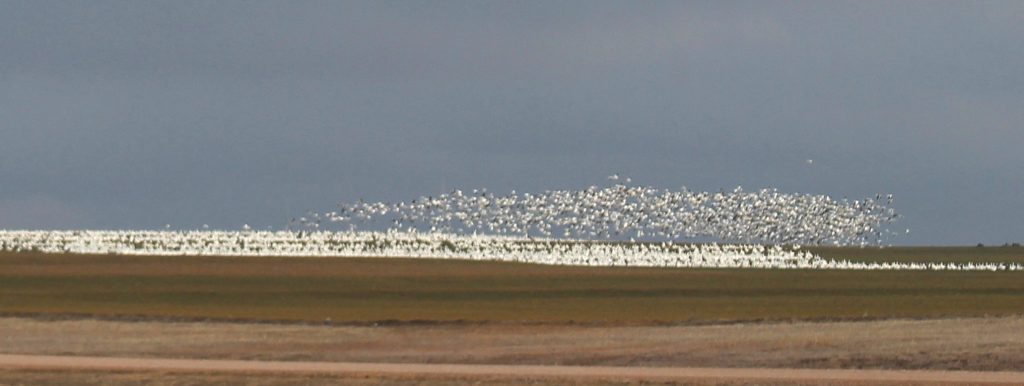By Jennifer Stultz
Tri-County Tribune Editor
jstultz@cherryroad.com
Thomas Bridrowski, waterfowl biologist with Kansas Department of Wildlife and Parks, is familiar with the half million or so migrating geese currently hovering over Pratt and outlying areas. He spends a majority of his time tagging, tracking, and studying migrating geese and ducks in the Kansas agriculture and wetlands areas of Cheyenne Bottoms, Quivira National Wildlife Refuge, and surrounding counties.
“I know that group over Pratt,” Bridrowski said. “We did a mid-winter survey of that area in January, flying over them in a little Cessna at 400 feet above U.S. Hwy. 281. Every so often we had to dodge a bird or two, but this is just an incredible time of year in this part of Kansas and the Central Flyway States.”
On Monday, Bridrowski was monitoring a flock of geese near Lindsborg, sitting by a large pond with nets attached to rockets and trying to catch geese individually for banding and tracking purposes.
“They come in January and stop here in Kansas as part of their journey to arctic breeding grounds. They feed in the field, rest, and re-stage their groups. By mid-March they will be gone. I always say to enjoy the geese while they here, it really isn’t that long, and then I look forward to when they come again next year.”
Bridrowski said there are some geese who do stay behind and establish local homes, but most are on a great journey north, following the females who are leading their mates to where they were born. It is all part of a timeless cycle of breeding, nesting, and migrating again. The will reach their arctic homes by June.
“There are some concerns about what damage they might do to fields and smaller bodies of water but for the most part they don’t really damage the farm ground they group on. The wheat is at a stage where it is not harmed unless the soil is muddy and then the heavy geese trample it down some,” Bridrowski said.
For the most part, the varieties of geese above Pratt and the surrounding areas can classified into several categories. There are Lesser Snow Geese, which are mostly white except for a few color-phase recessives that appear dark or have a blueish tinge. Ross’s Snow Geese travel with the Lesser Snow Geese are all white.
Canadian Geese, which can weigh 10-12 lbs. each, or the small Cackling Geese at 3-4 lbs. are additional varities common in the skies over Pratt at this time. These are both white-fronted fowl with big bars or speckled bellies.
All of the geese are fair game to hunters who have the proper licenses and geese stamps on their cards, Bridrowski said.
“Nearly all populations are in good shape and are not on a protected status at this time,” Bridrowski said. “The lighter geese are over abundant and that is why we have an extended hunting season that will go into mid-April.”
He said state and federal licenses to hunt are accessible online, as are websites with plenty of good goose-meat recipes.
“I eat them. They are very good,” he said. “They are primarily herbivores so they are making high protein from vegetation, just like other meats we eat.”
Bridrowski recommended checking out websites at KDWP, Arctic Goose Adventures, and Ducks Unlimited for more hunting and cooking information, as well as migration path and life cycles of wild geese.






